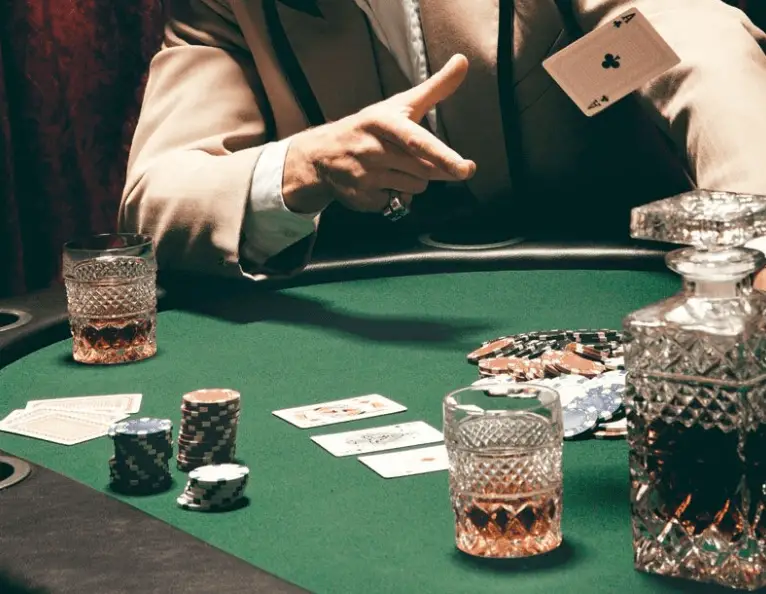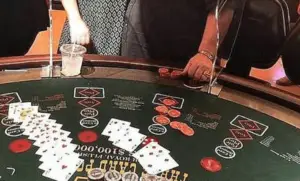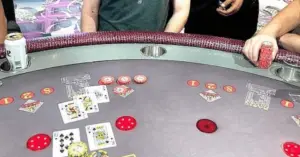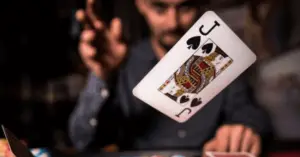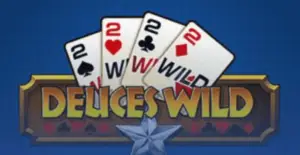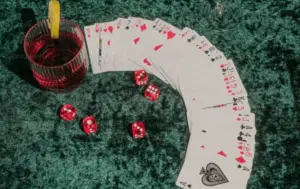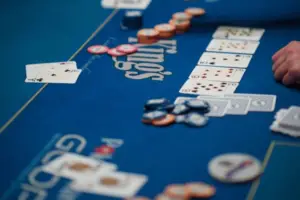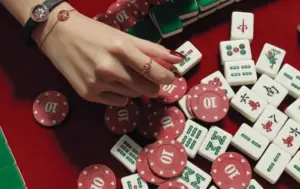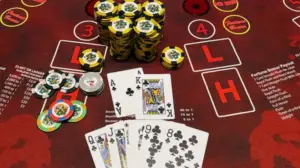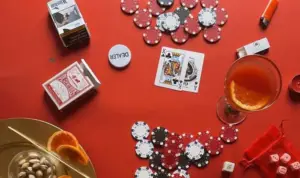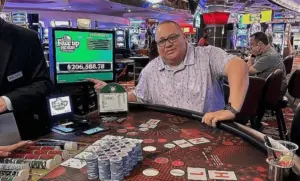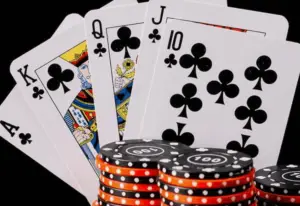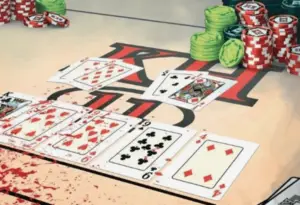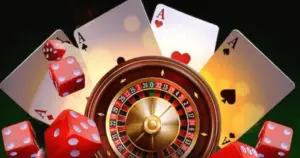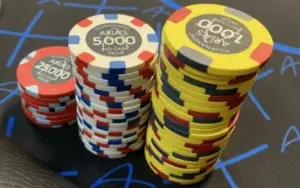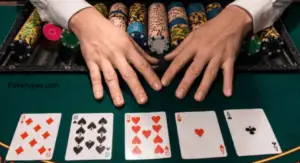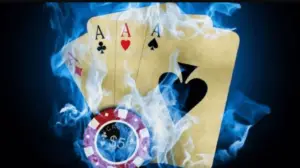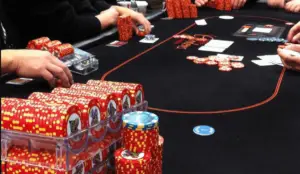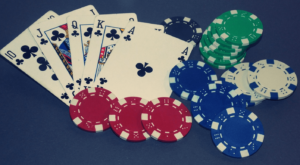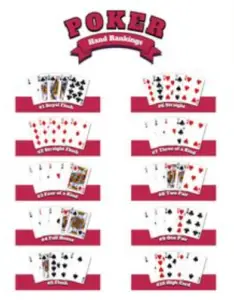Countdown Poker is an interesting variant of classic poker games like Seven Card Stud and Texas Hold’em. This exciting variant adds a wild card element that’s determined by the number of players left in the hand just before the final betting round.
For example, if three players remain, all 3s become wild cards. This unique rule keeps players on their toes, adding an extra layer of strategy and excitement to the game.
While the exact origins of Countdown Poker aren’t clear, it’s gained popularity among poker enthusiasts looking for a fresh challenge.
The game follows standard poker rules until the wild card is revealed, making it easy for experienced players to pick up.
Whether you’re playing Seven Card Stud Countdown or Texas Hold’em Countdown, you’ll need to balance your hand strength with player elimination to maximize your chances of winning the pot.
Game Variations of Countdown Poker
1. Countdown Seven Card Stud
Countdown Seven Card Stud is a popular variant of the classic Seven Card Stud game. Here’s how it works:
Gameplay Overview
Players start with two hole cards and one face-up card. As the game progresses, they receive more cards, just like in a regular Seven Card Stud. The wild card twist comes into play right before the final betting round.
Betting Rounds
The game follows the usual Seven Card Stud betting structure:
Third Street: After the initial deal, players bet based on their two hole cards and one up card.
Fourth Street: Players receive another up card and bet again.
Fifth Street: Another up card is dealt, followed by betting.
Sixth Street: Players get their sixth card face-up and bet once more.
Seventh Street: The final card is dealt face-down, but before betting, the wild card is determined.
Wild Card Determination
The number of players left in the hand decides the wild card. For example, if three players remain, all 3s become wild. This adds a thrilling element of surprise to the game!
2. Countdown Texas Hold’em
Countdown Texas Hold’em takes the wild card concept and applies it to the world’s most popular poker variant. Let’s break it down:
Gameplay Differences
The game follows standard Texas Hold’em rules until the River (fifth community card). Just before the final betting round, players determine the wild card based on the number of active players.
Community Cards and Wild Card Rules
Here’s where it gets interesting:
Community cards are never considered wild, even if they match the wild card number.
Only cards in players’ hands can be wild.
The wild card is set right before the River betting round.
For instance, in a game with four players left, all 4s in players’ hands become wild. If there’s a 4 on the board, it stays as-is.
Examples and Strategy
Let’s say you’re playing Countdown Texas Hold’em with five players. You’ve got A♠ 4♥ in your hand, and the board shows K♣ 7♦ 2♠ 9♣.
Before the River, two players fold. Now there are three players left, making 3s wild. The River comes 3♦. Your 4♥ isn’t wild anymore, but you can use that 3♦ as any card you want!
In Countdown Seven Card Stud, you might start with a 5♠ 5♣ (2♥) showing. As the hand progresses, you pick up A♦ K♠ Q♣.
If four players are left before the last card, 4s are wild. Your last card is 4♦ – jackpot! You now have a monster hand with three wild cards.
The wild card rule adds a layer of strategy. In both games, you’ll want to balance building a strong hand with keeping players in the game to potentially get a better wild card. Remember, the wild card can change the whole game in a heartbeat.
A seemingly weak hand can turn into a powerhouse, while a strong hand might lose its edge. It’s this unpredictability that makes Countdown Poker variants so exciting and keeps players on their toes
Core Rules and Mechanics of Countdown Poker
1. Wild Card Determination
The wild card is the heart and soul of Countdown Poker. It’s what makes this game a real nail-biter!
Timing of Wild Card Declaration
In Countdown Poker, the wild card is declared right before the final betting round. This happens:
In Seven Card Stud Countdown: Before the seventh card is dealt.
In Texas Hold’em Countdown: Just before the River (fifth community card) is revealed.
This timing keeps players on their toes until the very end!
Relationship to Remaining Players
Here’s the kicker: The wild card is determined by the number of players still in the hand. For example:
- If three players remain, all 3s become wild.
- With four players left, 4s are wild.
This rule adds a whole new layer of strategy. Players must balance building a strong hand with keeping others in the game for a potentially better wild card.
2. Betting Structures
Countdown Poker can be played with different betting structures, each adding its own flavor to the game.
Fixed Limit
In Fixed Limit games:
- Bets and raises are set at a fixed amount.
- For example, in a $1/$2 game, bets are $1 in early rounds and $2 in later rounds.
This structure keeps the game more predictable and budget-friendly.
Pot Limit
Pot Limit betting allows:
- Players to bet or raise up to the current pot size.
- More flexibility than Fixed Limit, but still with some constraints.
This structure can lead to bigger pots and more exciting play.
No Limit
In No Limit games:
- Players can bet their entire stack at any time.
- This structure creates the potential for massive swings and high-stakes drama.
3. Betting Actions
Players have several options during betting rounds, each with its own strategic implications.
Call
To call means to match the current bet. For example, if the bet is $5, you put in $5 to stay in the hand.
Raise
When you raise, you increase the current bet. In Fixed Limit games, the raised amount is usually double the current bet.
Fold
Folding means you’re out of the hand. You give up your cards and any chance at the pot, but you don’t lose any more money.
Check
You can check when there’s no bet to call. It’s like saying, “I’ll stay in, but I don’t want to bet.”
Bet
To bet is to put money into the pot when there’s no bet to call. This starts the action for that betting round.
Examples in Action
Let’s say you’re playing Texas Hold’em Countdown with five players. You’ve got A♠ 5♥in your hand. The flop comes K♣ 7♦ 2♠. Two players fold after the turn (9♣). Now there are three players left, so 3s are wild.
The river comes3♦– suddenly, your 5♥ can be any card you want! In a Seven Card Stud Countdown game, you might start with(5♠ 5♣) 2♥ showing. As the hand progresses, you pick up A♦ K♠ Q♣.
If four players are left before the last card,4s are wild. Your last card is 4♦– boom! You now have a monster hand with two wild cards.
Remember, in Countdown Poker, the wild card can turn the tables in a heartbeat. A seemingly weak hand can become a powerhouse, while a strong hand might lose its edge.
It’s this unpredictability that makes the game so thrilling and keeps players coming back for more!
How Countdown Poker Is Played?
Now let’s look at how a Countdown Poker game unfolds. We’ll use Texas Hold’em Countdown as our example, but remember, you can apply these rules to other poker variants too!
Dealing Hole Cards
Just like in regular Texas Hold’em, the dealer shuffles up and deals two hole cards face down to each player. These are your secret weapons, folks!
Blinds and Ante
The two players to the left of the dealer post the small blind and big blind. In some games, you might have an ante too. This gets the pot started and gives everyone something to fight for.
2. Betting Rounds
Pre-Wild Card Rounds
Now, we’ve got three betting rounds before the wild card comes into play:
Pre-flop: Players bet based on their hole cards.
Flop: Three community cards hit the table. More betting follows.
Turn: A fourth community card is dealt, with another round of betting.
These rounds play out just like regular Hold’em. You can call, raise, fold, or check depending on the action.
Wild Card Declaration
Here’s where things get spicy! Right before the River (the fifth and final community card), we determine the wild card.
Count the players still in the hand. That number becomes the wild card. For example, if three players remain, all 3s are now wild!
Final Betting Round
The River card is dealt, and we have one last round of betting. But now, players have to consider the wild card in their hand. A seemingly weak hand might suddenly become a powerhouse!
3. Showdown
Hand Revelation
If there’s more than one player left after the final betting round, it’s showdown time! Players reveal their hands, starting with the last person to bet or raise.
Winner Determination
The player with the best five-card hand takes the pot. Remember, you can use any combination of your hole cards and the community cards to make your best hand.
4. Hand Rankings
Standard Poker Hand Hierarchy
Countdown Poker uses the standard poker hand rankings, from highest to lowest:
- Royal Flush
- Straight Flush
- Four of a Kind
- Full House
- Flush
- Straight
- Three of a Kind
- Two Pair
- One Pair
- High Card
Impact of Wild Cards on Hand Strength
Wild cards can seriously shake things up! Here’s how they affect hand strength:
Five of a Kind: This becomes possible with wild cards and beats everything else.
Better “Natural” Hands: A hand without wild cards might beat a similar hand using wild cards in some games. Always check the house rules!
Easier Strong Hands: It’s easier to make hands like four of a kind or straight flushes with wild cards in play.
Example Hand
Let’s walk through a sample hand to see how this all comes together:
- Five players are dealt their hole cards. You’ve got A♠ 5♥.
- Pre-flop betting happens, and one player folds. Four remain.
- The flop comes K♣ 7♦ 2♠. Another round of betting, and one more player drops out. Three left.
- The turn is 9♣. More betting, but everyone stays in.
- Before the river, we determine the wild card. With three players, all 3s are now wild!
- The river comes 3♦. Suddenly, your 5♥ can be any card you want!
- Final betting round happens.
- At showdown, you reveal your hand. Your A♠ 5♥ with the 3♦ on the board gives you options. You could have two pair, three of a kind, or even a straight or flush depending on how you use that wild 3!
The unpredictability of the wild card is what makes Countdown Poker such a thrilling ride. A hand that looked mediocre can suddenly become a winner, or a strong hand might get outmatched by a lucky wild card. It’s this rollercoaster of emotions that keeps players coming back for more!
Strategy Considerations in Countdown Poker
1. Player Count Management
In Countdown Poker, keeping an eye on the number of players is key. It’s not just about your hand; it’s about who’s still in the game.
A. Influencing the Wild Card Value
Smart players try to steer the wild card to their advantage. If you’ve got a pair of 5s, you might want to keep more players in to make 5s wild. On the flip side, if you’ve got high cards, you might want to thin the herd.
B. Balancing Hand Strength and Player Elimination
It’s a tricky balancing act. You want a strong hand, but you also want the right number of players for a favorable wild card. Sometimes, it’s worth keeping a weaker player in just to get the wild card you need.
2. Wild Card Anticipation
Thinking ahead is crucial in Countdown Poker. You’ve got to be a bit of a fortune teller!
A. Predicting Potential Wild Cards
As the hand progresses, keep track of how many players are left. If there are four players after the turn in Texas Hold’em Countdown, you know 4s will be wild if no one folds. This info can shape your betting strategy.
B. Adjusting Play Based on Likely Outcomes
Let’s say you’ve got A♠ 4♥in a five-player game. After the flop, two players fold. Now, you know 3s will be wild if no one else folds. Suddenly, your 4♥ might become more valuable than your ace!
Comparison to Other Poker Variants
Countdown Poker shares some DNA with popular poker games, but it’s got its own special twist that makes it stand out from the crowd.
Similarities to Seven Card Stud and Texas Hold’em
Countdown Poker can be played using either Seven Card Stud or Texas Hold’em rules as a base. Here’s how they stack up:
In Seven Card Stud Countdown, you’ll get seven cards just like in regular Stud.
Texas Hold’em Countdown follows the same community card structure as its parent game.
Betting rounds in both versions mirror their classic counterparts.
Unique Aspects of Countdown Poker
The real kicker in Countdown Poker is the wild card rule. This game-changer pops up right before the final betting round. Here’s what makes it special:
The wild card is determined by the number of players left in the hand.
It adds a whole new layer of strategy and excitement.
Players must balance building strong hands with keeping others in the game for a better wild card.
For example, in a Texas Hold’em Countdown game with three players left, all 3s become wild just before the River. This can turn a so-so hand into a powerhouse in the blink of an eye!
Conclusion
Countdown Poker is a thrilling twist on classic poker games that keeps players on their toes. Its unique wild card rule, determined by the number of players left in the hand, adds an extra layer of excitement and strategy.
This game is perfect for both casual players looking for a fun night with friends and seasoned poker pros seeking a new challenge.
Whether you’re playing Seven Card Stud Countdown or Texas Hold’em Countdown, the game’s unpredictability makes every hand a nail-biter.
With its easy-to-learn rules and potential for big swings, Countdown Poker is a hit at home games and has even found its way into some casinos. It’s a game that truly levels the playing field, giving everyone a shot at glory with each wild card reveal.
